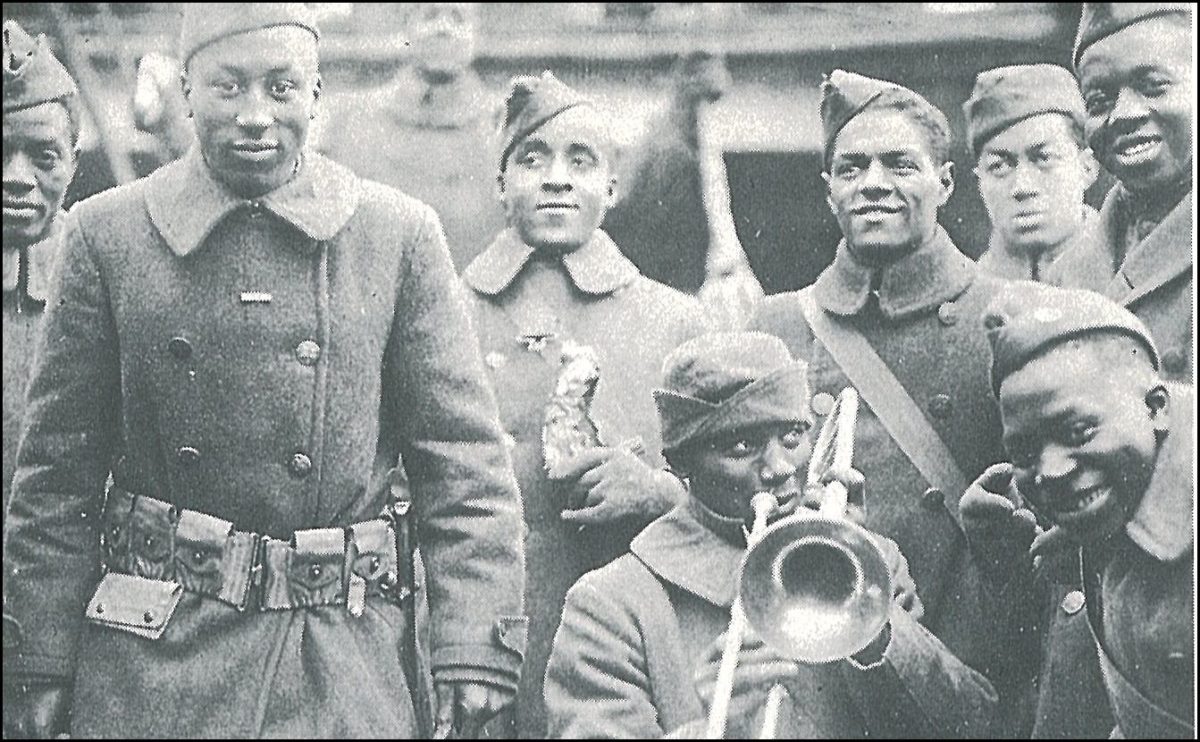A BUFFALO SOLDIER ON HERKIMER ST. (1930)

Brownstone Detectives investigates the history of our clients’ homes.
The story you are about to read was composed from research conducted in the course of one of those investigations.
Do you know the history of YOUR house?
********************************************************************************************************************************
It was 1918, and Harry Francis Cole had only three options.
As an African-American in the United States, drafted into the military when the country was entering the First World War, he could:
1) work as a non-combatant – laboring as a stevedore, digging trenches, graves, and latrines, or building hospitals, roads, bridges, and railroad lines,
2) fight in a segregated unit – as an American soldier with the French Army, whose soldiers did not object to fighting alongside African-American troops, or
3) join a military band – one of the many brass bands in the European theater that were composed of African-American musicians.

Cole, already a budding musician back home in Philadelphia, would naturally find himself in the last group, a horn player in one of the units of the 92nd Division – or, as the military unit was more commonly known, the venerated “Buffalo Soldiers.”
BORN TO WAIL
Born one of four children to William and Carrie Cole in Philadelphia in 1896, Harry Cole was never really destined to be a fighter. When he was a boy he was even then sure that his future was in music. He likely caught the bug when ragtime was all the craze, but when he heard the new sound of jazz in the 20th century, he must have known for certain what he was going to do with his life.
With the Harlem Renaissance about to bloom, he wanted to move to the center of it all. He focused on learning the the saxophone as the instrument most closely associated with jazz music and was soon playing in local groups around Philadelphia for several years, likely traveling to New York City to play gigs there, as well. Before his future in music could fully blossom, though, rumblings of a foreign war – and American involvement in it – could be heard. By 1918, when the U.S. finally entered the European conflict, Cole was 22 and eligible for the draft.
 BECOMING A BUFFALO & FIGHTING THE HUN
BECOMING A BUFFALO & FIGHTING THE HUN
Mustered out of Camp Dix, New Jersey, in June of 1918, Cole would be assigned to serve overseas in the all-black 350th Field Artillery Regiment. As each regiment had its own band back then he would be assigned to the specialty “musician, 3rd class,” and was soon a member of what would eventually be the renowned as the 350th’s “Black Devils.”
Although the Buffalo Soldiers were part of the United States Army, prejudices of the era prevented most African-American units from participating in combat with the American or British forces. As a result, many Buffalo Soldiers served as laborers. However, a few units, including the 92nd Division, served in combat with the French Army, whose soldiers did not object to fighting alongside African Americans. They were issued French equipment and arms but wore U.S. uniforms.
The 92nd Division, within which the 350th Field Artillery served, saw combat during the Meuse-Argonne Offensive, the ultimate battle of World War I, which claimed more than 26,000 American soldiers. Cole’s “350th” achieved significant recognition. Serving from 1 June 1918 to 18 March 1919, Cole and his unit would come under fire in the “Marbache” sector in October and November of 1918.
“Staying close to its regiment,” noted their band leader Tim Brymn, “the band was at hand in the bloody Argonne and Metz drives in fall 1918,” and at one point they were forced to “put down their instruments to fight.”
After the Armistice was signed, General John J. Pershing, the commander of the entire American Expeditionary Force (AEF), ordered Brymn’s 350th to make a tour of the entire front, winning recognition as “the only colored aggregation of musicians to appear before President Woodrow Wilson and General Pershing by special request during the tour of the battle front by the country’s Chief Executive prior to the opening of the peace conference.”
Away from the front, in concert, they played special engagements in Nancy, Marseilles, Bordeaux, Brest, and other cities. In addition, we know that Brymn’s band played for three weeks at a base hospital in Paris and at General Pershing’s great review of the 92nd Division on January 28 at Le Mans. Further, the memoirs of of the 350th’s drum major Willie “the Lion” Smith – originally a rag pianist – mention a visit of the band to the rest area at Aix-les-Bains.
THE BLACK DEVILS PLAY JAZZ

After the war had ended, Brymn kept the band together and immediately took advantage of their popularity back home, staging tours across the U.S. Thus, Brymn’s “Black Devils” were able to arrange to make extensive, immediate tours for profit as private citizens, and were able to keep their band more-or-less intact thereafter for an extended period. With jazz music the sensation sweeping the nation at the time the 70-member band played, along with their military tunes, a number of their originals as well as many of the popular jazz tunes of the day. They toured under their slogan, “A Military Symphony Engaged in a Battle of Jazz.” Soon after the tour, they made a series of recordings for the OKeh label.
Back in Harlem, Cole would also join the New Amsterdam Musical Association (NAMA), which today is the oldest African-American musical organization in the United States. It was founded at the time that the American Federation of Musicians Local 310 (now, Local 802) did not admit minority musicians. The reason for the creation of the union was that the law stated at the time that a musician had to be in a union in order to perform in New York City.
The NAMA has certainly been both a literal and figurative home for many jazz musicians throughout the ages, and it became a key cultural reference point for jazz music during the Harlem Renaissance from the 1920s through to the 1950s.
MOVING TO BED-STUY

294 Herkimer Street (1930 Federal Census).
Cole continued to play in bands throughout the 1920s, playing his own part in the Harlem Renaissance. He would eventually become a pioneer for other African-American musicians, once again, by eventually traveling out to Brooklyn during that decade to search for and buy a brownstone in the Bedford-Stuyvesant section. Locating a property on Herkimer Street – at No. 294 – he settled in with his wife, Cleo, and two other families, becoming a landlord.
In the 1930s, during the Depression, Cole would find gigs with the Works Progress Administration (WPA). Although not much can be found on him during this period, in September of 1935, he was one of three men, noted in a newspaper, who left a musical performance at Colonial Park (Bradhurst Avenue and 148th Street) where a regular “dancefest” was being held under the auspices of the Emergency Relief Bureau (E.R.B.), the forerunner of the Department of Welfare. There was no indication as to why he left, other than that some of the musicians may have thought that the dance had been called off and, thus, they left immediately.
Cole, though, must have been a respected member of the NAMA and also likely had some clout with the group, as, in December of 1935, the membership of the NAMA was holding it annual elections, and he was running for treasurer. This gives us an indication that Cole must have had a sense for numbers and finances, as he had already purchased his own house by this time. It is not known whether he was elected to the position.
By 1941, Cole was still engaged in a musical career as a part of a 35-piece ensemble sponsored by the New York City Music Project. He was living at the time just north of Harlem on Bradhurst Avenue, so it is likely that by this time he sold No. 294 Herkimer Street or he was renting it out.
Harry Francis Cole passed away in 1961. He is interred at the Long Island National Cemetery in Farmingdale, New York.
(Thanks to Peter M. Lefferts for his excellent paper, “Black US Army Bands and Their Bandmasters in World War I,” for much of the information relative to Harry Cole’s time with the 350th Field Artillery Band.)
———————————————————————————————————————–
 Brownstone Detectives is an historic property research agency. Our mission is to document and save the histories of our clients’ homes. From our research, we produce our celebrated House History Books and House History Reports. Contact us today to begin discovering the history of your home.
Brownstone Detectives is an historic property research agency. Our mission is to document and save the histories of our clients’ homes. From our research, we produce our celebrated House History Books and House History Reports. Contact us today to begin discovering the history of your home.